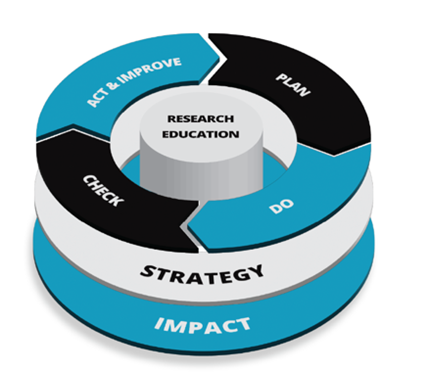Basis and procedures for quality management
Quality at the University of Eastern Finland refers to the appropriateness of the university’s activities to achieve a high level of quality and impact in education and research. Quality work and continuous development are an integral part of strategic management and the university’s activities.
The Quality Policy is the university’s policy on the objectives, principles, and responsibilities for quality.
The UEF Board is responsible for the university’s quality principles and policies. The Leadership Group acts as the university’s quality management team and the Rectors are responsible for quality work in line with their own division of labour. Deans of faculties, heads of departments and units, and heads of university services are responsible for the performance and quality of their own functions.
The university’s Quality Group is responsible for developing and guiding the practical quality work. The university’s quality coordinators and people in charge of quality in the faculties and units work together with staff and students on day-to-day quality work.
The university has long collaborated in quality work with other national and international universities (YUFE) and campus cities, for example through various quality-related projects.
A quality university culture means a university community atmosphere that supports quality. A culture of quality is reflected in the commitment of staff and students to their work and studies, working together in accordance with the values and objectives of the university, and following common practices. Based on feedback from customers and continuous evaluation, the activities are developed and good practices are effectively disseminated within the university.
The development of the university’s activities is based on the systematic use and analysis of various indicators and feedback systems describing activities and results, as well as on audits and other evaluations of activities. Quality management is a way of ensuring that the university’s practices are appropriate, justified, and managed.
The university’s activities and development are based on the principle of continuous development
Plan – Do – Check –Act/Improve.

Figure 8 High-quality activities at UEF
Quality management as part of leadership
One of the overarching themes of the university’s strategy is continuous development.
The purpose of strategic management and operational management is to implement the university’s strategy and processes and to improve their quality, as well as ensuring that the university’s activities are proactive and based on continuous analysis of the operating environment. Quality management is an essential part of strategic management. The quality system ensures that the university’s strategic objectives are met. Quality work supports the achievement of the strategic objectives of the vision defined in the university’s strategy and the continuous development of its activities. Leadership Group work is integrated into the university’s planning, development, and reporting processes.
The university’s management system and organisation have been reformed, for example by clarifying the division of responsibilities within the deanery. In addition to a dean, the faculties have deputy deans for teaching and research, the units have appointed persons responsible for teaching and research, and the division of responsibilities between faculties and departments has been clarified. Strengthening the management system will enable more systematic monitoring of the quality of operations and addressing areas for improvement.
The university’s key functions are integrated into the management system. The Deans lead the Faculty Councils and the Academic Rector leads the Council of Teaching and Guidance. The heads of the independent and service institutions are involved in various bodies.
Knowledge management has been improved by developing strategic indicators and their monitoring through the introduction of new monitoring tools. Quality management has been better linked to strategic management through the development of the management review and internal audit processes, and management has been actively involved in their development. The link between strategic and operational management and quality management is described in more detail in the following image.

Figure 9 Strategic leadership, performance management and quality
The Quality Group includes staff representation from faculties and departments and student representation from the Student Union. Students are involved in quality management in various institutions and development projects. The university’s management meets regularly with the Student Union and student associations. Doctoral researchers have representatives on the Doctoral School’s management team. Students and post-doctoral researchers have the opportunity to provide feedback on activities and processes through a variety of channels.
University services carry out a service survey approximately every two years. The feedback from the survey is used to develop activities. For example, in the 2022 survey, the majority of feedback was about the findability of information in both the Heimo Services and Yammer. Based on feedback, a Yammer newsletter was piloted during spring 2022 to find relevant information in the Current News and Students groups.
| Strengths | Enhancement areas |
| Quality management is part of the university’s strategic management and governance | Developing strategic indicators and reporting on quality and risk management to support strategic management |
| Developing management reviews and internal audits to support management, and the university’s leadership has actively participated in their development | Closer integration of quality management documentation with other documentation of the university’s activities (knowledge management) |
| A network of quality managers and quality actors at different levels with clear responsibilities and tasks. Information flows quickly from one level to another. | Making quality work more visible, what it means in everyday life for both staff and students, including through the development of communication about quality work and better dissemination of good practice. |